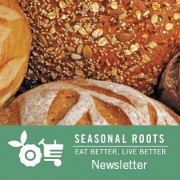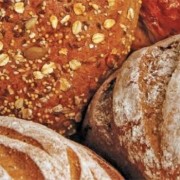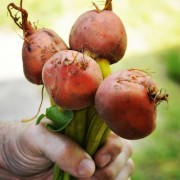This local baker grinds fresh whole wheat flour daily. Is it worth it?
– By the Veggie Fairy Team
Two of our most popular breads are the honey whole wheat and the 9-grain from Great Harvest Bread Company in Mechanicsville, Va. They’re both really popular with Seasonal Roots members, partly because they’re full of whole wheat goodness, but also because they’re just delicious.
Seasonal Roots is all about fresh local food, so we wanted to know if the freshness factor has anything to do with how good and tasty this bread is. Is just being fresh-baked enough? What about the flour — how fresh does that have to be? We talked with June, the bakery’s owner and head baker, but first the backstory.
Does grain have to be fresh to be good?
We all know that when it comes to produce, freshness counts — the minute veggies and fruits are harvested, they start losing their vitamins. The longer they’re exposed to air, light, and heat, the more vitamins they lose.
Does the same thing apply to whole grains? After all, in their unmilled seed form, grains are designed to last at least until next year’s planting. The thing is, once you grind those whole grains for flour, the seed’s protective coating is crushed to pieces and some of the sensitive insides are exposed to air. Air is the enemy of vitamins B, A, and E, which are all found in whole grains.
Now we do eat grains for more than just the vitamins. Grains are an excellent source of energy, fiber, and proteins, and we can only access those nutrients once the grain is ground into flour. The vitamins do help with the digestion of these important nutrients, but we also get those vitamins in the other things we eat. So even if the flour isn’t super fresh, it still has a lot to offer.
But taste-testing bread connoisseurs will tell you that the freshness of the flour definitely affects the taste of the bread. Just like freshly harvested produce, freshly ground whole grains are more flavorful, plus they still have most of their original vitamins.
So when you have the choice, bread that’s fresh-baked from freshly ground flour is always better, as we discovered in our conversation with June of Great Harvest Bread Co. in Mechanicsville.
VEGGIE FAIRY:
So what part does freshness play at your bakery?
JUNE:
To make good quality bread, it really is a science and freshness is one of the most important factors. We get started at 4:00am every morning, fresh milling our 100% whole wheat flour daily right here in the bakery. We’ve got our own stone-grinding mill because the fresh milling is really the key. When you grind your wheat fresh it maintains the quality so you’ve got more nutrients, more proteins, and definitely more flavor!

June in her element!
VEGGIE FAIRY:
What are some of the other factors that go into quality bread?
JUNE:
Definitely the ingredients. For the honey whole wheat bread, we use only five simple ingredients: fresh milled whole wheat flour, yeast, salt, honey, and water. No preservatives, the water’s filtered, and the wheat is non-GMO. The same ingredients go into the 9-grain, both red and white wheat, plus buckwheat, corn, rye, barley, flax, millet, and oats.

Some of the kneading crew, working their magic.
VEGGIE FAIRY:
Have you always been a baker?
JUNE:
When I was little I loved baking pies from scratch with my mother, but then I grew up and worked in the insurance industry. After 25 years of that, I was ready to give up the corporate world and that childhood experience was my inspiration. So I started my own Great Harvest franchise.

The bakery staff are like family.
VEGGIE FAIRY:
Why a franchise? Why not just open “June’s Bakery”?
JUNE:
The franchise really simplified the business side of it, and taught me the science side, too. So for five years now I’ve been able to focus on my favorite parts of what I do. I have a passion for the bread and I’m a people person. The staff here at the bakery are like family. There are eight of us, including two with autism, and everyone’s an important part of the team. And I love getting to know our customers, they’re like family, too. We love to share samples with everybody. We’re also big on bakery tours with Girl Scout troops and elementary schools.

June with the whole grain bakers of tomorrow!
VEGGIE FAIRY:
Sounds like you’re really part of your community.
JUNE:
We are, this is where we live and work. We really try to live our mission: Be loose and have fun. Bake phenomenal bread. Run fast to serve others. And give generously. We donate bread to area church food pantries, to make sure it goes to local families in need. And we donate on several levels to local charities, like giving them gift certificates that they can use to get nutritious, flavorful bread for free. We really appreciate everyone who shops local and shops fresh, people like the members of Seasonal Roots.
Want to drop in and meet June and her team at Great Harvest Bakery Company in Mechanicsville? Directions and more are right here.
And here are some tips on whole grains from the USDA, including how to store whole grain bread.
ABOUT SEASONAL ROOTS
Since 2011, Seasonal Roots’ online farmers market has connected Virginia families with local family farmers who use sustainable, humane practices. Our veggie fairies – mostly moms who believe in living better through scrumptious, healthy eating, being kind to animals, protecting the environment, and spreading joy – home-deliver freshly harvested produce, eggs, grass-fed dairy and meat, plus artisan fare. We empower our members to eat better and live better with more nutritious, flavorful food that’s good for us and good for the planet. More info at seasonalroots.com.








